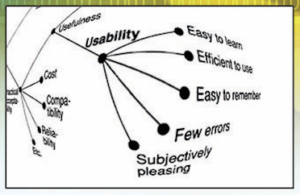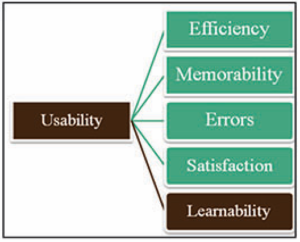

Go to Admin » Appearance » Widgets » and move Gabfire Widget: Social into that MastheadOverlay zone
 Continued from part 3, in this session lets look at the aspects that make any system more user friendly. User friendliness of any system consists of the factors including usability of system, efficiency in performing tasks, memorability of how to carry out the particular task, number of errors occurred in its normal use and the satisfaction of its users. Lets look at these factors in detail in context of proven researches.
Continued from part 3, in this session lets look at the aspects that make any system more user friendly. User friendliness of any system consists of the factors including usability of system, efficiency in performing tasks, memorability of how to carry out the particular task, number of errors occurred in its normal use and the satisfaction of its users. Lets look at these factors in detail in context of proven researches.
Usability of Systems
According to Jakob Neilsen (Nielsen, 1993), the acceptability fo the system which is whether it is good enough to satisfy the needs and requirements of the users and other potential stakeholders, is determined by various factor.
 A model of the attributes of system acceptability (Nielsen, 1993).
A model of the attributes of system acceptability (Nielsen, 1993).
It breaks down the system acceptability into different attributes which must be accepted by the end-users/stakeholders for the system to be aceepted. Social acceptability implies whether
System acceptability is determined by its social and practical acceptability. Social acceptability refers to the fact that the system is widely approved by different social groups e.g. it does not contradict anybodies religious believes, etc. Practical acceptability refers to more traditional aspects like costs, support, compatibility with existing systems, etc.
For the sake of this study, the one attribute of practical acceptability which is needed t be looked at is Usefulness of the system, which tells whether the system can be used to achieve the desired goals it was intended for. Usefulness is further divided into Utility, which refers to the functionality of the system, whether it can do what is needed; and Usability, which determines how well users can use the functionality. Until recently, utility aspects have been the main centre of attention of developers and other stakeholders but as the use of computers increased developers realised that a system with all required functionalities which is not easy to use is no good, therefore a considerable amount of attention should be given to the usability aspects of any system/software from an early stage in its development.
 There are various definitions of usability available in the literature, some even contradict each other. But the most widely used official definition of usabilty given by ISO 9241-11 and ISO 2002a which states that ” the extent to which a product can be used by specified users to achieve specified goals with effectiveness, efficiency, and satisfaction in a specified context of use, where:
There are various definitions of usability available in the literature, some even contradict each other. But the most widely used official definition of usabilty given by ISO 9241-11 and ISO 2002a which states that ” the extent to which a product can be used by specified users to achieve specified goals with effectiveness, efficiency, and satisfaction in a specified context of use, where:
– Effectiveness measures the accuracy and completeness with which users achieve specified goals;
– Efficiency measures the resources expended in relation to the accuracy and completeness with which users achieve goals;
– Satisfaction measures the freedom from discomfort, and positive attitudes towards the use of the product.” (Wachowicz M., 2003)
Therfore from the ISO definition and according to Jakob Neilsen, usabiltiy of a system is not a single dimension property of a user interface, it rather consists of multiple components and is attributed with the attributes given below (Nielsen, 1993):
• Learnability
• Efficiency
• Memorability
• Errors
• Satisfaction
• Learnability
“How easy is it for users to accomplish basic tasks the first time they encounter the design?” (Nielsen, 2003)
It is the most fundamental usability attribute, since every system needs to be easy to learn and since the first experience any user has with the new system is learning to use the system. In some cases, users can be trained to use the difficult interface but this is an expensive option and most of the time this is not feasible. Therefore, the interface design needs to be easy-to-learn.
The ease of learning refers to novice user’s experience. The users of the system should be able to learn and reach at adequate level of usage proficiency within short time. To enable system to be easily learnable, it must be designed according to the expertise level of majority of its users. Formerly, learnability studies only focussed on users with no previous computer experience but with the passage of time, more people are becoming computer literate, therefore it is important to include those users in the learnability studies.
The learnability of the system can be tested in two different ways. Users may be required to complete a set of tasks successfully when they use the computer for the first time. The alternative way is to set a minimum time in which users are required to complete the tasks successfully, to be considered as being proficient with the system.
Most users do not learn the interface fully and straight away jump in to using a system. Therefore the designer should keep this in mind and they should not only measure the time it takes someone to master the system but also try to minimise the time it will take someone to achieve a sufficient level of proficiency to do useful work.
Efficiency
Once users have learned the design, how quickly can they perform tasks? (Nielsen, 1993)
Efficiency refers to the expert users’ steady state level of performance when they have mastered the system. But on the other side, this might not be measured so easily, as some systems i.e. complex operating systems, may take several years to master or achieve expert-level performance; also some people may continue to learn indefinitely.
Experienced users of the system are required to measure the efficiency of that system. More hours spent on using the system may refer to a user being considered more experienced. For a new system without an established user base; users are asked to use the system for some amount of time and then efficiency is measured. For these users, their performance is measured continuously i.e. by the time they spent on some task; and it is assumed that they have reached the maximum level of learning the system when there is no progress made in their performance for some time.
According to Nielsen, “A typical way to measure efficiency of use is thus to decide on some definition of expertise, to get a representative sample of users with that expertise, and to measure the time it takes these users to perform some typical text tasks.” (Nielsen, 1993)
Memorability
“When users return to the design after a period of not using it, how easily can they re-establish proficiency?” (Nielsen, 2003)
There are novice users who do not know anything about the system, and then there are expert/experienced users who have reached the steady-state level of performance in using the system. But there is one another type of users; casual users, they have used the system so they are not novice but they are not experienced either as they do not use the system frequently.
Casual use is usually seen with application programs which are only used in exceptional cases and not used on regular basis. Users who have stopped using the system for long interval for some reason or came back from holidays and now start using the system again can also be considered as casual users. Therefore, the interface design must accommodate those types of users by making it easier for the users to remember how to operate the system, even when they come back after sometime. This minimises the users’ effort of re-learning the system and user will not hesitate or put of the system.
According to Nielsen (Nielsen, 1993), improved learnability of any system also makes the user interface easier to remember. Therefore it can be said that the both usability attributes are directly proportional to each other. Memorability of the interface is rarely tested but it can be measured in two ways. The first method is to get some users who have been away from the system for the specified amount of time and carry out a user testing, measuring the time it takes them to completing typical set of tasks any typical user will perform on the system. Second method is to carry out a memory test of users when they finish a test session, by asking them questions on different commands of system and the number of correct answers represents the interface’s score.
Errors
“How many errors do users make, how severe are these errors, and how easily can they recover from the errors?” (Nielsen, 2003)
Any action at the interface which does not accomplish a desired goal is considered as an error and the interface should be designed so that users make as few errors as possible. Error rate is the number of errors users make in completing some specified task and can be measured as part of an experiment.
Some errors are minor as they only tend to increase the transaction time and do not affect the system as much – they are seen and corrected by users at runtime. But the errors which are not seen by users can be catastrophic and may have disastrous affect on the outcome and/or system. These major errors must be counted separately from minor errors and efforts should be made to minimise their frequency.
Satisfaction
“How pleasant is it to use the design?” (Nielsen, 2003)
Subjective satisfaction attribute asks how pleasant it is to use the system. It is an especially important attribute for entertainment systems where users might want to spend more time on having fun rather than getting things done quickly. “Users should have an entertaining and/or moving and/or enriching experience when using such systems since they have no other goal.” (Nielsen, 1993)
Subject satisfaction can be accurately measured by monitoring users, heart rate, pupil dilation, skin conductivity, etc. to find out when they are amused by the interface but unfortunately these required a special experimental conditions and equipment which is a very costly option and is not feasible in most cases. The alternative is to ask users what and how they feel about there experience with the system to determine whether it pleases the majority of the user base or failed in achieving this.
You must be logged in to post a comment Login